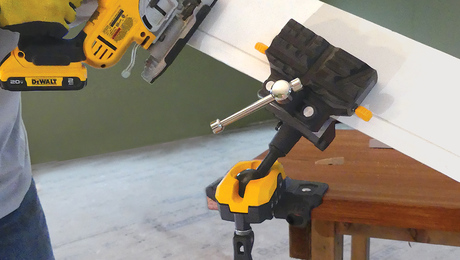This isn’t for me… The local HfH builds their crawlspace houses with parged exteriors on their cinderblock foundations. Some are quite high due to lot topology – say up to 7′ or even 8′. They have problems with hairline cracks occasionally forming in parge job, which are often in the stair-step shape of the block running bond. Mind you, these aren’t serious cracks – maybe a few feet in length and maybe 1/16″ wide – max. There isn’t much un-balanced fill, so really, this shouldn’t be happening. My first Q was if the masons are using the proper amount of ladder wire. I then suggested that they have their masons use one of the fiber parge products like Surewall (sp?) or QuickWall (sp?) for parging. Their response was that it was too expensive – which it is a little pricey.
OK – so my next suggestion was to add fiber mesh to the parge, which I think would work – I actually did it on my own home for below grade block parging before the damp-proofing was applied. Anyway, does anyone know anything about doing this? Would there be some other kind of ad-mixture that could help like maybe an acrylic or latex? There are several other threads running here at BT about stucco – which we don’t see much of around here especially after the 90s EFIS screw-ups. Seems like stucco techniques could be applicable though…
Other thoughts or suggestions? I’m just collecting some info for my friend who is very involved with HfH.




















Replies
OK - consider this a bump...
Over the last few days I did some searching here at BT and some Googling. Came up with more Qs than answers.
Fiber: I found out there are several kinds, namely polypropylene, PVA - polyvinyl alcohol, nylon and steel, to name a few. I kinda gather that polypropylene is the "regular stuff". I also saw some reference to "stucco grade fiber" but I never really could quite define what that was... One guy said use "fibermesh green bag" which I guess is some specific brand... Further I get the idea that maybe one could use the same fiber concrete batch plants use for residential concrete.
Mortar: they are currently using Type-S mixed with regular mason's sand for the single coat parge. I saw some reference to using Type-N. Would Type-N be less likely to crack; more flexible or something like that? I know Type-S is stronger but maybe more brittle? I'm thinking Type-S is the right way to go. I also saw some reference to making your own out of cement, lime and sand. Not sure that would be a good way to go as probably the bricklayers would charge more just because they aren't used to it erasing any material savings and would likely not work out too good as the brickies would be out of their comport zone and would really just create more room for error.
Additives - I saw some reference to using acrylic and latex additives but I kinda got the idea that was more for adhesion - which isn't really the problem. Hairline cracks is the problem.
B-bond - What is that? I saw several references to that, but a Google didn't turn up much. Is that a brand name or product name?
Hey Matt, Can't help you out, sounds interesting and I'm curios. So consider this a BUMP........ .DAVEhttp://s182.photobucket.com/albums/x208/dryhter/
?action=view¤t=mz_0508_10009669134-1.gif
Edited 5/25/2007 5:33 pm ET by DPR9
Don't have any direct advice. There is a technique for dry stacking concrete blocks that uses the fibers. The claim is that it is significantly stronger than a conventional wall with mortar. I assume they use the same type of fibers that you are thinking of. You might be able to get some additional information by doing a Google search on "dry stack" or "surface bonding", and "CMU" or "Block". I read of one individual who was doing the dry stacking technique who used some type of synthetic mesh material that he got at the local fabric store. Might be all kinds of things you could imbed to add strength.
"Fiber: I found out there are several kinds, namely polypropylene, PVA - polyvinyl alcohol, nylon and steel, to name a few. "You sure that PVA is a fiber?I have always heard of it used as a bonding agent and as an additive to increase stickness and bonding..
.
A-holes. Hey every group has to have one. And I have been elected to be the one. I should make that my tagline.
Matt,I used surface bonding cement on my foundation insulation as a parge in 1984 in Colorado. The fibers were pretty coarse glass fibers, about 1/2" long. They were much larger than fibermesh, and quite stiff. If I didn't slick it down just right, it ended up looking like cake frosting with a layer of shredded coconut stuck to it. This mortar was called "Q-Bond" and was rated for building surface-bonded block walls, an interesting technology that stalled in the USA for reasons I do not know.Bill
It's been some time since I used surface bonding cement but that's what I was thinking... that the fiber was thicker and stiffer. On the other hand in this application they really don't need a structural parge, just something that looks OK - as in no cracks.
Anyone know anything about what kind of fiber is used as an admixture in Stucco? Would the polypropylene fiber mesh that is used in concrete be appropriate for this application? How would it work just tossing it in the mixer?
Since the cracks echo the grout lines of the blocks, one solution might be to isolate the parge from the block. This might be more trouble than it is worth (and there is probably a better solution from someone who knows more about it than I!), but if you but in some kind of slip sheet and then attach wire to hold the parge....
But this advice might well be worth considerably LESS than what you paid for it.
Rich Beckman
You are here.
Sounds like something is settling, to me.
If not, you can just wipe the dracks with some more parge mix, rubbing it into the crack really well.
In the furture, thouroughly wet the walls the day before parging and keep them damp for a week after. Any cracks that develop after that, WILL be due to settling.
SamT
Praise the Corporation, for the Corporations' highest concern is the well being of the public.
Did a block and bond job years ago - the parging cracked wherever there was a mortar joint (every 4' vertical?)
Are they putting the parging on pretty soon after laying the block? I wonder if slight shrinkage in the mortar is causing/contributing to the cracks
With my mouth I will give great thanks to the Lord; I will praise Him in the midst of the throng. For He stands at the right hand of the needy, to save them from those who would condemn them to death.
- Psalms 109:30-31
Not sure what you would mean by "(every 4' vertical?)" There is a horizontal joint every 8" between each course as you go up the wall, and since it's a running bond of 8"x8"x16" blocks there is a vertical joint every 16" on each course.
Anyway... I'll try to get some pics. This is not a really big deal, and not every foundation has a crack in it. OTOH, one crack in any new foundation, even if it is just cosmetic, is one more crack than is desirable.
He could try some glue in the mix. He could add some to one area and see if that does it. Just one area on the same wll so there were two mixes to compare.
I worked with a mason on stone walls and he used the glue a lot. It does make the mortar much stronger.
the cost is still going to go up though so how much he adds is going to be an issue. If he doesn't add enough it won't do anything I guess.
Maybe follow the recomendations of the manufacturer? Instructions on the bottle?
Glue? What kind of glue?
I think it is called PVA but I'm going from a spotty memory. We just called it concrete glue.
There are TWO different PVA's.Polyvinyl acetate - the most common application is wood glue.http://en.wikipedia.org/wiki/Polyvinyl_acetate
http://www.thistothat.com/glue/pva.shtmlBut it is also used in some concrete bonding agents.http://www.noxcrete.com/vinyl-hesive.shtml"Reemulsifiable,
Water Based, Polyvinyl
Acetate (PVA) Bonding
Agent And Admixture
For Interior Concrete,
Cementitious Mixes,
Stucco And Plaster.Use To Improve The
Bond Strength Of
Cementitious Repairs
And Overlays Made
To New Or Existing
Concrete.Use To Improve The
Strength Properties
And Performance Of
Cementitious Repairs
Or Overlays."But PVA is also polyvinyl alcohol which is used to make fibers for concrete.http://www.kuraray-am.com/pvaf/faq.php
.
.
A-holes. Hey every group has to have one. And I have been elected to be the one. I should make that my tagline.
Thanks Bill. Those are some pretty interesting links. And it's interesting to know what "white glue" and "carpenters glue" are PVA glues - a fact which it appears isn't commonly known.